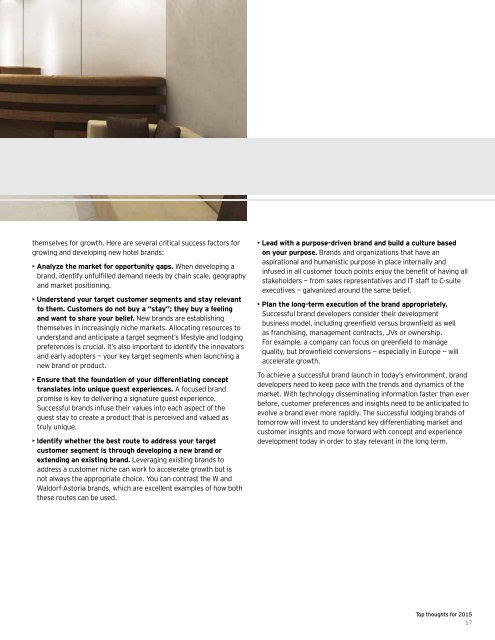ey-global-hospitality-insights-2015
ey-global-hospitality-insights-2015
ey-global-hospitality-insights-2015
You also want an ePaper? Increase the reach of your titles
YUMPU automatically turns print PDFs into web optimized ePapers that Google loves.
themselves for growth. Here are several critical success factors forgrowing and developing new hotel brands:• Analyze the market for opportunity gaps. When developing abrand, identify unfulfilled demand needs by chain scale, geographyand market positioning.• Understand your target customer segments and stay relevantto them. Customers do not buy a “stay”; th<strong>ey</strong> buy a feelingand want to share your belief. New brands are establishingthemselves in increasingly niche markets. Allocating resources tounderstand and anticipate a target segment’s lifestyle and lodgingpreferences is crucial. It’s also important to identify the innovatorsand early adopters — your k<strong>ey</strong> target segments when launching anew brand or product.• Ensure that the foundation of your differentiating concepttranslates into unique guest experiences. A focused brandpromise is k<strong>ey</strong> to delivering a signature guest experience.Successful brands infuse their values into each aspect of theguest stay to create a product that is perceived and valued astruly unique.• Identify whether the best route to address your targetcustomer segment is through developing a new brand orextending an existing brand. Leveraging existing brands toaddress a customer niche can work to accelerate growth but isnot always the appropriate choice. You can contrast the W andWaldorf-Astoria brands, which are excellent examples of how boththese routes can be used.• Lead with a purpose-driven brand and build a culture basedon your purpose. Brands and organizations that have anaspirational and humanistic purpose in place internally andinfused in all customer touch points enjoy the benefit of having allstakeholders — from sales representatives and IT staff to C-suiteexecutives — galvanized around the same belief.• Plan the long-term execution of the brand appropriately.Successful brand developers consider their developmentbusiness model, including greenfield versus brownfield as wellas franchising, management contracts, JVs or ownership.For example, a company can focus on greenfield to managequality, but brownfield conversions — especially in Europe — willaccelerate growth.To achieve a successful brand launch in today’s environment, branddevelopers need to keep pace with the trends and dynamics of themarket. With technology disseminating information faster than everbefore, customer preferences and <strong>insights</strong> need to be anticipated toevolve a brand ever more rapidly. The successful lodging brands oftomorrow will invest to understand k<strong>ey</strong> differentiating market andcustomer <strong>insights</strong> and move forward with concept and experiencedevelopment today in order to stay relevant in the long term.Top thoughts for <strong>2015</strong>17


